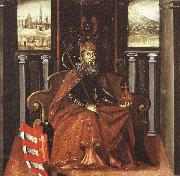China al por mayor de Marco de Oleo
|
|
|

|
|
|
|
|
|
|
|
|
|
|
|
|
|
|
El clic para Ampliar
|
| Saint Ladislaus, King of Hungary
|
| 1600 Oil on wood, 103 x 101,3 cm Hungarian National Gallery, Budapest Of the Hungarian kings St Ladislas is perhaps the one most often represented in post-medieval frescoes, altar paintings and statues. In the Middle Ages he was associated with the ideal of chivalry and the legends which gathered around him determined the manner of his representation. Thus the knightly armour and the battle-axe have become permanent attributes, in addition to the crown and the orb. The painting illustrated here, dating from the late sixteenth century, is only superficially linked with medieval portraits of St. Ladislas. The king is shown seated on a throne wearing an ample, richly embroidered cloak studded with pearls round the hem. In the foreground is a voluted and foiled shield with the national emblem, stylized in harmony with the throne. The background is designed to suggest the interior of a Renaissance palace. Through opening on either side of the wall behind the throne - draped with embroidered hangings - there is a view of landscape. A similar motif was often used to fill in the background in north Italian Madonna paintings of the fifteenth and sixteenth centuries. The monochrome landscape on the left is a topographic reference to one of St. Ladislas' most important church activities, the foundation of the Cathedral in Nagyv?rad, while the one on the right shows his legendary defeat of the Cumanian abductor. This evocation of two popular episodes from the story of the king's life is intended partly to identify St. Ladislas as a rule of worldly power, and partly to indicate the ideal unity of the Christian king and the Christian knight. St Ladislas is shown as a historical personage, without a halo - a fact indicating that the painting was destined for a secular building. The episodes from the king's life or, to be mere accurate, from legends associated with his name, are treated as historical facts. The same approach characterized the series of prints of royalty and other notabilities which became so popular all Europe in the course of the sixteenth century. It may be assumed that such prints served as models for the painted portrait of St. Ladislas and the two related pictures of St. Stephen and St Emeric. Artist: UNKNOWN MASTER, Hungarian , Saint Ladislaus, King of Hungary , 1551-1600 , Hungarian , painting , religious
|
|
|
| Pintura identificación:: 65257
|
|
|
|
|
|
|
|
|
unknow artist
1600 Oil on wood, 103 x 101,3 cm Hungarian National Gallery, Budapest Of the Hungarian kings St Ladislas is perhaps the one most often represented in post-medieval frescoes, altar paintings and statues. In the Middle Ages he was associated with the ideal of chivalry and the legends which gathered around him determined the manner of his representation. Thus the knightly armour and the battle-axe have become permanent attributes, in addition to the crown and the orb. The painting illustrated here, dating from the late sixteenth century, is only superficially linked with medieval portraits of St. Ladislas. The king is shown seated on a throne wearing an ample, richly embroidered cloak studded with pearls round the hem. In the foreground is a voluted and foiled shield with the national emblem, stylized in harmony with the throne. The background is designed to suggest the interior of a Renaissance palace. Through opening on either side of the wall behind the throne - draped with embroidered hangings - there is a view of landscape. A similar motif was often used to fill in the background in north Italian Madonna paintings of the fifteenth and sixteenth centuries. The monochrome landscape on the left is a topographic reference to one of St. Ladislas' most important church activities, the foundation of the Cathedral in Nagyv?rad, while the one on the right shows his legendary defeat of the Cumanian abductor. This evocation of two popular episodes from the story of the king's life is intended partly to identify St. Ladislas as a rule of worldly power, and partly to indicate the ideal unity of the Christian king and the Christian knight. St Ladislas is shown as a historical personage, without a halo - a fact indicating that the painting was destined for a secular building. The episodes from the king's life or, to be mere accurate, from legends associated with his name, are treated as historical facts. The same approach characterized the series of prints of royalty and other notabilities which became so popular all Europe in the course of the sixteenth century. It may be assumed that such prints served as models for the painted portrait of St. Ladislas and the two related pictures of St. Stephen and St Emeric. Artist: UNKNOWN MASTER, Hungarian , Saint Ladislaus, King of Hungary , 1551-1600 , Hungarian , painting , religious
|
|
Related Paintings to unknow artist :.
| Mrs John Winthrop dfg | en strandpromenade | Portrait of Antonina Radziwill | Sitting old man | Music school diploma | |
|
|
|
|
|
|
CONTACTE EEUU
China de Xiamen el Petróleo al por mayor que Pinta la Barra de Soga Marco al por mayor que Moldea el Espejo Pinturas Estiradas Encuadradas |
|








